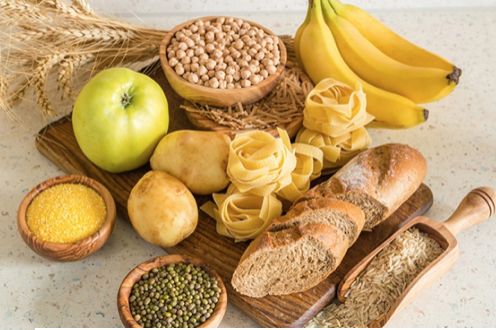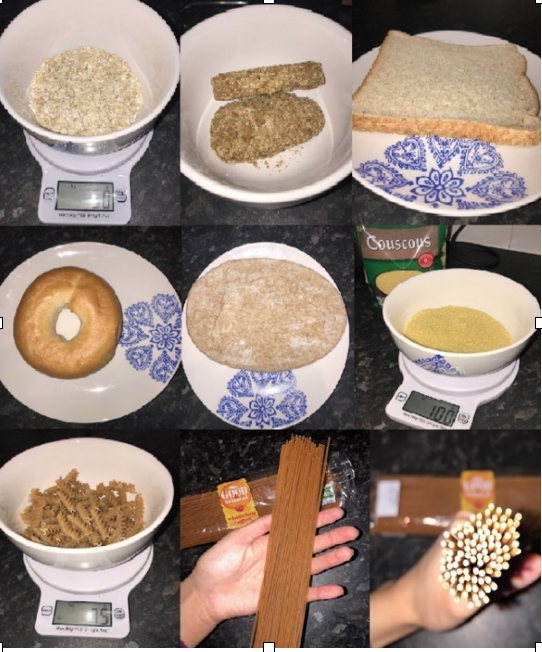By Rosie Jasper, student dietitian.
Many thanks to Rosie for this blog post. Carbs are a huge topic that I myth bust on and talk to clients about every week… so I know you will find this helpful.
I don’t know about you but I’m sick and tired of seeing celebrities, Instagram influencers and articles in the media encouraging us to cut out key components of our diets, for example carbohydrates!
Apparently cutting out sugar and therefore carbohydrate sources is the key to losing weight according to some top celebrity influencers such as Jennifer Lopez, who was promoting a 10 day no sugar, no carbohydrate challenge!
Sugars are carbohydrates; when we consume foods containing carbohydrates (such as those previously mentioned), our bodies break these down into simple sugars called glucose. Glucose is an essential part of our diet as it provides our body, including our brain with the energy it requires to function on a daily basis.

Carbohydrate containing foods also contain essential vitamins and minerals that are required to keep our bodies working as effectively as it should; a lack of nutrients could cause lead to a decrease in energy, mood and brain function. A decrease in mood may mean that we’re more likely to opt for ‘comfort foods’, that are often high in fat, salt and refined sugar, which defeats the object of the aimed weight loss and the vicious cycle begins. Therefore, by cutting out all carbohydrates in the diet, it’s subsequently removing important nutrients our bodies need.
As suggested by the Eatwell Guide, a third of the food we consume should be starchy foods and carbohydrates should form 50% of our energy intake daily. It is recommended that when choosing starchy foods, we should opt for wholegrain varieties where possible instead of their white/refined varieties.
Examples of wholegrains:
- Wholegrain bread
- Wholegrain pasta
- Brown rice
- Quinoa
- Bulgur
- Wheat based cereals e.g. – Wheat biscuits, Bran Flakes, muesli (opt for the no added sugar or salt variety)
White/refined products have been processed and includes foods like white bread, white pasta and white rice. During processing many of their nutrients including B vitamins, vitamin E, fibre and minerals are removed; however, we need all of these nutrients as they provide many health benefits such as providing energy, having antioxidant effects, keeping our digestive system healthy and for maintenance of bone, teeth, nerves, hair etc. Wholegrain carbohydrates include the whole grain and therefore maintain its nutrients.
Carbohydrates do not naturally lead to weight gain if eaten in moderation, however it is true that eating carbohydrates excessively can lead to an increase in weight. Carbohydrates have many important roles in the body and shouldn’t be avoided due to the fear of weight gain.
The important role of carbohydrates in the body:
- Our main source of energy – starchy foods are broken down more slowly than free sugar products and therefore provides us with a steady release of energy during the day
- Brain function – the brain requires a steady glucose supply in order to function properly
- Wholegrain starchy products contain B vitamins, vitamin E, fibre and minerals
- Fruits and vegetables contain naturally occurring sugar and are packed with essential vitamins and minerals to help keep our bodies healthy
- Fibre is a type of carbohydrate and helps to keep our digestive system healthy, reduce likelihood of constipation, reduce cholesterol and a diet high in fibre has also been associated with a lower risk of bowel cancer
- A diet low in carbohydrates is associated with low energy levels, a decreased brain function and low mood
It is recommended that we aim for 5 portions of starchy foods per day (260g). To put it in to perspective this is what 1 portion of a starchy carbohydrate looks like. An easy portion guide is for your cooked carb to fill your cupped hand. There is no need to weigh foods out each time you cook then, just weigh it once and find something it fits in like a tea cup to use as a household measure.
- 50 dry oats/ ½ cup
- 2 wheat biscuits
- 1 slice of bread
- 1 bagel
- 1 naan bread
- 100g dry cous cous/ ¾ cup/approximately 2 hands full
- 75g dry pasta/ ¾ cup/approximately 2 hands full
- 75g spaghetti (when bunched together should be the same width as a £1 coin)

The portions of pasta, cous cous and oats may look small when uncooked but when water is added to them and they are cooked, they increase in size and weight. Then when vegetables and/or lean meat is added the portions will bulk out more to create a balanced dish. Meals should be based around starchy foods and adding extra ingredients will contribute to a healthy, balanced diet and increase the nutrient content.
Fibre is also a type of carbohydrate that is found in plant-based foods, however it’s not absorbed or digested and therefore doesn’t impact our blood sugar levels, so doesn’t need to be classed as part of your daily CHO.
Benefits of fibre:
- Promote regular bowel movements
- Prevents constipation
- Helps to control blood glucose levels
- Reduces cholesterol
Wholegrain varieties of starchy foods, fruit and vegetables especially when eaten with their skin on, e.g. – potatoes, apples and pears are all excellent sources of fibre.
Meal ideas including their carbohydrate and fibre content
| Meal | Carbohydrate content (g) | Fibre content (g) |
| 50g oats made and water 80g berries | 37 | 6 |
| 2 wheat biscuits 135ml semi skimmed milk Sliced banana | 53 | 5 |
| Wholegrain bagel Low fat spread Salmon Cottage cheese | 42 | 7 |
| 2 slices of wholegrain toast Low fat spread Peanut butter | 31 | 7 |
| 75g dried pasta ½ tin of chopped tomatoes 80g peas 80g broccoli 20g spinach | 64 | 16 |
| Medium sized jacket potato ½ tin of baked beans 30g cheddar cheese | 63 | 15 |
T
Endorsement of faddy diets in the media should be taken with a pinch of salt (or sugar in this case!), remember a lot of these people have personal dietitians, chefs, personal trainers, photoshop and surgery to achieve their ‘dream bodies’ that you see online. Removing main food groups, even for a short period of time is not healthy or sustainable and shouldn’t be encouraged.